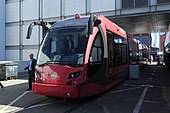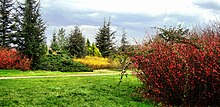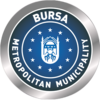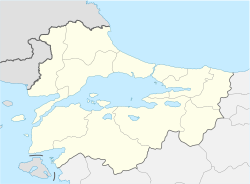
Bursa
Bursa | |
|---|---|
City | |
Clockwise from top: Hüdavendigar Park; Green Mosque; Irgandı Bridge and Orhan Gazi Square; nostalgic tram on Cumhuriyet Avenue; Koza Han; and Bursa – Mt. Uludağ gondola lift | |
Location of Bursa within the Region of Marmara in Turkey | |
| Coordinates: 40°11′N 29°03′E / 40.183°N 29.050°E | |
| Country | |
| Region | Marmara |
| Province | Bursa |
| Government | |
| • Mayor | Mustafa Bozbey (CHP) |
| Area | |
• City | 10,422 km2 (4,024 sq mi) |
| • Urban | 1,290 km2 (500 sq mi) |
| • Metro | 17,806 km2 (6,875 sq mi) |
| Elevation | 100 m (300 ft) |
| Population (2021 estimation)[1] | |
• City | 3,101,833 |
| • Density | 300/km2 (770/sq mi) |
| • Urban | 1,999,998 |
| • Urban density | 1,600/km2 (4,000/sq mi) |
| • Metro | 2,161,990 |
| • Metro density | 120/km2 (310/sq mi) |
| Demonym | Bursalı (Turkish) |
| GDP | |
| • City | ₺ 609 billion US$ 37 billion (2022) |
| • Per capita | ₺ 192,098 US$ 11,591 (2022) |
| Time zone | UTC+3 (TRT) |
| Postal code | 16000 |
| Area code | (+90) 224 |
| Licence plate | 16 |
| Website | www.bursa.bel.tr |
| Official name | Bursa and Cumalıkızık: the Birth of the Ottoman Empire |
| Type | Cultural |
| Criteria | i, ii, iv, vi |
| Designated | 2014 (38th session) |
| Reference no. | 1452 |
| Region | Europe |
Bursa (Turkish pronunciation: [ˈbuɾsa]) is a city in northwestern Turkey and the administrative center of Bursa Province. The fourth-most populous city in Turkey and second-most populous in the Marmara Region, Bursa is one of the industrial centers of the country. Most of Turkey's automotive production takes place in Bursa. As of 2019, the Metropolitan Province was home to 3,056,120 inhabitants, 2,161,990 of whom lived in the 3 city urban districts (Osmangazi, Yıldırım and Nilüfer) plus Gürsu and Kestel.[1]

Bursa was the first major and second overall capital of the Ottoman State from 1335 until 1360s. A more recent nickname is Yeşil Bursa ("Green Bursa") referring to the parks and gardens located across the city, as well as to the vast, varied forests of the surrounding region.

Bursa has a rather orderly urban growth and borders a fertile plain. The mausoleums of the early Ottoman sultans are located in Bursa, and the city's main landmarks include numerous edifices built throughout the Ottoman period. Bursa also has thermal baths, old Ottoman mansions, palaces, and several museums. Mount Uludağ, known in classical antiquity as the Mysian Olympus or alternatively Bithynian Olympus, towers over the city, and has a well-known ski resort.

The shadow play characters Karagöz and Hacivat are based on historic personalities who lived and died in Bursa in the 14th century.[3]

History

The earliest known human settlement near Bursa's current location was at Ilıpınar Höyüğü around 5200 BC.[4] It was followed by the ancient Greek city of Cius, which Philip V of Macedon granted to Prusias I, the King of Bithynia, in 202 BC. King Prusias rebuilt the city with the advice of general Hannibal of Carthage, who took refuge with Prusias after losing the war with the Roman Republic and renamed it Prusa (Ancient Greek: Προῦσα; sometimes rendered as Prussa). After 128 years of Bithynian rule, Nicomedes IV, the last King of Bithynia, bequeathed the entire kingdom to the Roman Empire in 74 BC. An early Roman Treasure was found near Bursa in the early 20th century. Composed of a woman's silver toilet articles, it is now in the British Museum.[5]

Under Byzantine rule, the town became a garrison city in 562, where imperial guards were stationed. Already by the mid-6th century, Bursa was known as a famous silk textile manufacturing centre.[6]

Bursa (from the Greek "Prusa") became the first major capital city of the early Ottoman Empire following its capture from the Byzantines in 1326. As a result, the city witnessed a considerable amount of urban growth such as the building of hospitals, caravanserais and madrasas throughout the 14th century, with the first official Ottoman mint established in the city.[6] After conquering Edirne (Adrianople) in East Thrace, the Ottomans turned it into the new capital city in 1363, but Bursa retained its spiritual and commercial importance in the Ottoman Empire.[7] The Ottoman sultan Bayezid I built the Bayezid Külliyesi (Bayezid I theological complex) in Bursa between 1390 and 1395[8] and the Ulu Cami (Grand Mosque) between 1396 and 1400.[9] After Bayezid was defeated in the Battle of Ankara by the forces of Timur in 1402, the latter's grandson, Muhammad Sultan Mirza, had the city pillaged and burned.[10] Despite this, Bursa remained as the most important administrative and commercial centre in the empire until Mehmed II conquered Constantinople in 1453. The population of Bursa was 45,000 in 1487.

| Year | Pop. | ±% |
|---|---|---|
| 1487 | 45,000 | — |
| 1927 | 61,451 | +36.6% |
| 1955 | 128,875 | +109.7% |
| 1980 | 487,604 | +278.4% |
| 2000 | 1,184,144 | +142.8% |
| 2015 | 1,854,285 | +56.6% |

During the Ottoman period, Bursa continued to be the source of most royal silk products. Aside from the local silk production, the city imported raw silk from Iran, and occasionally from China, and was the main production centre for the kaftans, pillows, embroidery and other silk products for the Ottoman palaces until the 17th century.[12] Devshirme system was also implemented in Bursa and its surroundings where it was negotiated between the authorities and locals. For example, during the 1603-4 levy, the villagers of a Christian village called Eğerciler, in Bursa, declared that they were responsible for providing sheep to the capital, and the children of the village were very much needed as shepherds. They asserted that even though they were not obliged to give any children to the army, the officers took some anyway, and that they should be returned. The villagers’ claim that it was in tremendous need of future shepherds was taken seriously by the state, and a decree commanded the return of the children.[13] Bursa was also notable for its numerous hammams (bath) built during the reign of Suleiman such as the Yeni Kaplıca.[6] From 1867 until 1922, Bursa was the capital of Hüdavendigâr vilayet. As it was a significant cultural and trade hub, traders, most of whom were Armenians, became very wealthy.[14] The most influential study of Bursa's silk trade and economic history is the work of Ottomanist Halil İnalcık.[15]

In July 1915, thousands of Greek Orthodox Christians sought refuge in Bursa after having been forced out of their coastal villages by orders of the Young Turk government. This worsened the situation of the native Greeks of Bursa, who had managed to survive through the attacks and boycotts of 1914. A short time later, deportation orders came for Bursa's Armenians. Protestant Armenians were initially spared from deportation, but villagers that tried to resist were massacred. Most of the deportees would perish in what became known as the Armenian Genocide. Subsequently, large numbers of Kurds and Circassians, as well as Syrians from the south, were settled in the homes and towns of the deported Christians, radically altering the demographic composition of the town and region.[16] According to Mustafa Zahit Oner, in the last days of the Greco-Turkish War in 1922, the Greek Army attempted to burn the center of Bursa however they were stopped by the allied commanders and were only able to burn the train station together with Turkish civilians in it.[17] The Cretan artilleryman Vasilios Moustakis describes the event with the following words: "The Infantry had come through and set fire to the station. We saw an English general on horseback, who ordered the fire to be put out because if Bursa were burned, it would be harming Greece".[18]


Following the foundation of the Republic of Turkey in 1923, Bursa became one of the industrial centres of the country. The economic development of the city was followed by population growth, and Bursa became the 4th most populous city in Turkey.

The city has traditionally been a pole of attraction, and was a major centre for refugees from various ethnic backgrounds who immigrated to Anatolia from the Balkans during the loss of the Ottoman territories in Europe between the late 19th and early 20th centuries. The most recent arrival of Balkan Turks took place between the 1940s and 1990s, when the People's Republic of Bulgaria expelled approximately 150,000 Bulgarian Turks to Turkey.[19] About one-third of these 150,000 Bulgarian Turkish refugees eventually settled in Bursa (especially in the Hürriyet neighbourhood). With the construction of new industrial zones in the period between 1980 and 2000, many people from the eastern provinces of Turkey came and settled in Bursa.

Geography
The area covered by Bursa corresponds to 1.41% of Turkey's land area, which makes the city 27th in the country in terms of land area.[21] Bursa stands on the northwestern slopes of Mount Uludağ (known as the Mysian Olympus in classical antiquity), on the banks of the Nilüfer River, in the southern Marmara Region. It is the capital city of Bursa Province, which borders the Sea of Marmara and Yalova to the north; Kocaeli and Sakarya to the northeast; Bilecik to the east; and Kütahya and Balıkesir to the south.

Climate
Bursa has a (Köppen climate classification: Csa) under the Köppen classification, and a dry-hot summer subtropical climate (Csa) under the Trewartha classification. The city has hot, dry summers that last from June until September. Winters are cool and damp, also containing the most rainfall. There can be snow on the ground which will last for a week or two. Air pollution is a chronic problem in Bursa.[22]

| Climate data for Bursa (1991–2020, extremes 1928–2023) | |||||||||||||
|---|---|---|---|---|---|---|---|---|---|---|---|---|---|
| Month | Jan | Feb | Mar | Apr | May | Jun | Jul | Aug | Sep | Oct | Nov | Dec | Year |
| Record high °C (°F) | 25.2 (77.4) |
26.9 (80.4) |
32.5 (90.5) |
36.2 (97.2) |
37.0 (98.6) |
41.3 (106.3) |
43.8 (110.8) |
42.6 (108.7) |
40.3 (104.5) |
37.3 (99.1) |
32.1 (89.8) |
27.3 (81.1) |
43.8 (110.8) |
| Mean daily maximum °C (°F) | 9.8 (49.6) |
11.4 (52.5) |
14.6 (58.3) |
19.2 (66.6) |
24.4 (75.9) |
28.9 (84.0) |
31.5 (88.7) |
31.7 (89.1) |
27.6 (81.7) |
22.2 (72.0) |
16.6 (61.9) |
11.5 (52.7) |
20.8 (69.4) |
| Daily mean °C (°F) | 5.4 (41.7) |
6.5 (43.7) |
9.0 (48.2) |
13.0 (55.4) |
18.1 (64.6) |
22.6 (72.7) |
25.1 (77.2) |
25.2 (77.4) |
20.8 (69.4) |
15.9 (60.6) |
10.7 (51.3) |
7.0 (44.6) |
14.9 (58.8) |
| Mean daily minimum °C (°F) | 1.7 (35.1) |
2.4 (36.3) |
4.1 (39.4) |
7.4 (45.3) |
12.0 (53.6) |
16.2 (61.2) |
18.4 (65.1) |
18.7 (65.7) |
14.8 (58.6) |
10.8 (51.4) |
6.0 (42.8) |
3.3 (37.9) |
9.6 (49.3) |
| Record low °C (°F) | −20.5 (−4.9) |
−19.6 (−3.3) |
−10.5 (13.1) |
−4.2 (24.4) |
0.8 (33.4) |
4.0 (39.2) |
8.3 (46.9) |
7.6 (45.7) |
3.3 (37.9) |
−1.0 (30.2) |
−8.4 (16.9) |
−17.9 (−0.2) |
−20.5 (−4.9) |
| Average precipitation mm (inches) | 79.2 (3.12) |
78.2 (3.08) |
74.9 (2.95) |
68.6 (2.70) |
47.9 (1.89) |
42.8 (1.69) |
14.3 (0.56) |
17.5 (0.69) |
50.1 (1.97) |
84.4 (3.32) |
67.3 (2.65) |
93.9 (3.70) |
719.1 (28.31) |
| Average precipitation days | 14.87 | 13.60 | 13.40 | 11.43 | 9.63 | 7.30 | 3.33 | 3.60 | 6.77 | 10.67 | 10.93 | 14.53 | 119.8 |
| Average snowy days | 5.08 | 3.71 | 1.46 | 0.08 | 0 | 0 | 0 | 0 | 0 | 0.04 | 0.42 | 2.42 | 13.21 |
| Average relative humidity (%) | 75.3 | 72.8 | 70.7 | 69.3 | 67.1 | 63.1 | 59.6 | 61.7 | 67.3 | 74.6 | 75.5 | 75.7 | 69.4 |
| Mean monthly sunshine hours | 83.7 | 90.4 | 124.0 | 165.0 | 217.0 | 264.0 | 300.7 | 275.9 | 217.0 | 145.7 | 111.0 | 77.5 | 2,071.9 |
| Mean daily sunshine hours | 2.7 | 3.2 | 4.0 | 5.5 | 7.0 | 8.8 | 9.7 | 8.9 | 7.0 | 4.7 | 3.7 | 2.5 | 5.6 |
| Source 1: Turkish State Meteorological Service[23][24] | |||||||||||||
| Source 2: NOAA (humidity),[25] Meteomanz[26] | |||||||||||||
Economy

Bursa is the largest production centre of the Turkish automotive industry.[27] Factories of motor vehicle producers like Fiat, Renault and Karsan, as well as automotive parts producers like Bosch, Mako, Valeo, Johnson Controls, Delphi have been active in the city for decades. The textile and food industries are equally strong, with Coca-Cola, Pepsi Cola and other beverage brands, as well as fresh and canned food industries being present in the city's organized industrial zones.

Apart from its large automotive industry, Bursa also produces a substantial amount of dairy products (by Sütaş),[28] processed food (by Tat),[29] and beverages (by Uludağ).[30]


Traditionally, Bursa was famous for being the largest centre of silk trade in the Byzantine and later the Ottoman empires, during the period of the lucrative Silk Road. The city is still a major centre for textiles in Turkey and is home to the Bursa International Textiles and Trade Centre (Bursa Uluslararası Tekstil ve Ticaret Merkezi, or BUTTIM). Bursa was also known for its fertile soil and agricultural activities, which have decreased in the recent decades due to the heavy industrialization of the city.

Bursa is a major centre for tourism. One of the most popular skiing resorts in Turkey is located on Mount Uludağ, just next to the city proper. Bursa's thermal baths have been used for therapeutical purposes since Roman times. Apart from the baths that are operated by hotels, Uludağ University has a physical therapy centre which also makes use of thermal water.

Transportation

Bursa has a metro (Bursaray), trams[31] and a bus system for inner-city public transport, while taxi cabs are also available. Bursa's Yenişehir Airport is 20 mi (32 km) away from the city centre. The citizens of Bursa also prefer Istanbul's airports such as Istanbul Airport and Sabiha Gökçen International Airport for flights to foreign countries, due to Istanbul's proximity to Bursa. There are numerous daily bus and ferry services between the two cities.


The 8.8 km (5.5 mi) long Bursa Uludağ Gondola (Turkish: Teleferik) connects Bursa with the ski resort areas 1,870 m (6,140 ft) high on the mountain Uludağ.[32]

The only railway station in Bursa is the Harmancık station on the Balıkesir-Kütahya railway, which was opened in 1930.

The average amount of time people spend commuting with public transit in Bursa, for example to and from work, on a weekday is 62 min. 12% of public transit riders ride for more than 2 hours every day. The average amount of time people wait at a stop or station for public transit is 18 min, while 31% of riders wait for over 20 minutes on average every day. The average distance people usually ride in a single trip on public transit is 8.1 km (5.0 mi), while 17% travel for over 12 km (7.5 mi) in a single direction.[33]

Education

Bursa has two public universities and one private university. Uludağ University, founded in 1975, is the oldest institution of higher education in the city. Founded first as the Bursa University then renamed Uludağ University in 1982,[34] the university has a student body of 47,000, one of the largest in Turkey. Bursa Technical University[35] is the second public university of Bursa and was established in 2010, beginning education in the 2011–2012 academic year.

The first private university in Bursa was the Bursa Orhangazi University,[36] which started education in the 2012–2013 academic year. However, Orhangazi University was shut down by the Turkish government after the failed coup attempt of July 2016.

Istanbul Commerce University has opened graduate programs in Bursa in 2013.[37]

The vocational high schools, Bursa Sports High School,[38] and Bursa Agriculture Vocational High School,[39] are located in Osmangazi district.

Sports

The city has one professional football club, Bursaspor, which formerly competed in the Süper Lig (Super League), the top-tier of Turkish football, until finishing 16th at the end of the 2018–19 Süper Lig season and being relegated to the TFF First League. A few years earlier, Bursaspor had managed to become the Turkish champions at the end of the 2009–10 Süper Lig season, thereby becoming the second Anatolian club to ever win the Süper Lig championship title after Trabzonspor. Henceforth, Bursaspor was often considered to be one of the five biggest football clubs in Turkey, along with Galatasaray, Fenerbahçe, Beşiktaş and Trabzonspor. The club's relegation to the TFF First League at the end of the 2018–19 season was a major shock for its fans and became a first in the history of Turkish football. Never had a club which had won the Süper Lig championship title been relegated.

Bursaspor plays its home games at the Timsah Arena (meaning "Crocodile Arena", crocodile being the mascot of the team), which has a seating capacity of 45,000.

The city has three professional basketball teams in the Turkish Basketball League, Bursaspor and Tofaş S.K., which is among the most successful teams. The club plays its games at the Tofaş Nilüfer Sports Hall. Also, Final Spor plays in the second division.

Politics
Bursa district Municipalities Local elections, 2024 | |
|---|---|
| AKP | 9 / 17
|
| CHP | 6 / 17
|
| IYIP | 2 / 17
|
The current mayor of the Bursa Metropolitan Municipality Mustafa Bozbey is elected from the main opposition party (CHP) in March 2024.

Alinur Aktaş from the Justice and Development Party (AKP) was in office between 2019 and 2024, the AKP coalition won 49.6% of the vote against the CHP coalition which got 47% of the vote.[40]

Main sights
Ulu Cami (Grand Mosque)

Ulu Cami is the largest mosque in Bursa and a landmark of early Ottoman architecture, which incorporated many elements from Seljuk architecture.

Ordered by Sultan Bayezid I, the mosque was designed and built by architect Ali Neccar in 1396–1400. It is a large and rectangular building, with a total of twenty domes that are arranged in four rows of five, and are supported by 12 columns. Supposedly the twenty domes were built instead of the twenty separate mosques which Sultan Bayezid I had promised for winning the Battle of Nicopolis in 1396. The mosque has two minarets.


Inside the mosque, there are 192 monumental wall inscriptions written by the famous calligraphers of that period. There is also a fountain (şadırvan) where worshipers can perform ritual ablutions before prayer; the dome over the şadırvan is capped by a skylight which creates a soft, serene light below; thus playing an important role in the illumination of the large building.


The horizontally spacious and dimly lit interior is designed to feel peaceful and contemplative. The subdivisions of space formed by multiple domes and pillars create a sense of privacy and even intimacy. This atmosphere contrasts with the later Ottoman mosques (see for example the works of Suleiman the Magnificent's chief architect, Mimar Sinan.) The mosques that were built after the conquest of Constantinople (Istanbul) by the Ottoman Turks in 1453, and influenced by the design of the 6th century Byzantine basilica of Hagia Sophia, had increasingly elevated and large central domes, which create a vertical emphasis that is intended to be more overwhelming; to convey the divine power of Allah, the majesty of the Ottoman Sultan, and the governmental authority of the Ottoman State.



Places of interest
A brief list of the places of interest in and around Bursa is presented below. For a longer list, see the places of interest in Bursa.

Mosques and külliye complexes
- Bursa Grand Mosque and külliye
- Yeşil Mosque and külliye
- Bayezid I Mosque and külliye
- Muradiye Mosque and külliye
- Emir Sultan Mosque and külliye
- Orhan Gazi Mosque and külliye
- Hüdavendigar Mosque and külliye
- Koca Sinan Paşa Mosque and külliye
- İshak Paşa Mosque and külliye
- Karacabey Grand Mosque
- Karabaş-i Veli Cultural Centre
- Somuncu Baba Mosque
- Üftade Tekkesi Mosque and complex
- Babasultan Mosque and complex
Bazaars and caravanserais
Other historic monuments
- Bursa Castle
- Irgandı Bridge
- İnkaya Sycamore, a massive and impressive 600-year-old tree (Platanus orientalis)
Museums
- Bursa Archaeological Museum
- Bursa Atatürk Museum,[41]
- Bursa City Museum,[42]
- Bursa Energy Museum
- Bursa Forestry Museum
- Bursa Karagöz Museum
- Bursa Museum of Turkish and Islamic Art
- Bursa Turkish Architecture Museum
- İznik Museum
- Mudanya Armistice House
- Museum of Ottoman House
- Tofaş Museum of Cars and Anatolian Carriages
Parks and gardens
- Uludağ National Park
- Bursa Zoo and Botanical Garden
- Bursa Hüdavendigar Kent Park
Hot springs and thermal baths
- Keramet hot spring
- Çekirge hot spring
- Armutlu hot spring
- Oylat hot spring
- Gemlik hot spring
- Çelik Palas thermal bath
Beaches
- Kumla beach
- Kurşunlu beach
- Orhangazi beach
- Mudanya beach
- Manastir beach
- Kapakli beach
Jewish community
Bursa, initially home to a small Romaniote Jewish community, underwent a demographic shift with the arrival of Sephardic Jews who were expelled from the Iberian Peninsula in the late 15th century. The Sephardic majority quickly absorbed the Romaniotes, leading to a cultural and numerical dominance. Judaeo-Spanish became the daily language, and the community paid its poll tax through the representative, the kahya.[43]

Throughout the Ottoman period, most Jews resided in Kuruçeşme, Bursa's Jewish quarter, home to three synagogues. Etz Chaim (Eṣ Ḥayyim), the oldest, predated Ottoman conquest, while the Gerush and Mayor synagogues were established by Sephardic newcomers. Despite the 1851 fire destroying Etz Chaim, the other two remain, along with the Berut synagogue. Bursa also had a Jewish cemetery until recently.[43]

Though never a major center, Bursa's Jewish population fluctuated. Dubious data suggests 683 families in 1571/72, dropping to 141 by 1696/97. By 1883, there were 2,179 Jews, with an influx of 400 from Akkerman in 1887. Pre-World War I, the population reached 3,500, but emigration reduced it to 140 by the early 21st century.[43]

Engaged in the local economy, Bursa's Jews were shop owners and involved in guilds. In the 16th and 17th centuries, they excelled in textile manufacturing, silk trade, goldsmithing, and finance. Despite economic struggles in the 18th and 19th centuries, a 1886 report highlighted poverty.[43]

Bursa faced blood libels in 1592 and 1865. Despite its size, the community produced renowned halakhic scholars across centuries. Modern schooling arrived in 1886 with Alliance Israélite Universelle, but it closed in 1923 during the secularization program. Jewish children then attended Turkish schools for a modern education.[43]

Gallery
-
Bursa Citadel Main Gate
-
Orhan Gazi Mosque
-
Entrance of the Yeşil Cami (Green Mosque)
-
Muradiye Mosque and Külliye in Bursa
-
Governorate of Bursa
-
Mt. Uludağ is a popular ski destination.
-
Statue of Atatürk in Bursa
-
Şehreküstü Mosque
-
Interior of Yeşil Mosque
-
Bursa French Catholic Church
-
Saltanatkapı (Citadel Main Gate)
-
Old City Hall
-
Tophane Clocktower
-
Tomb of Osman Gazi
-
Tomb of Orhan Gazi
-
Interior of the Grand Mosque
-
Koza Han (Silk Bazaar)
-
A view of Bursa in the late 19th century
-
Bursa, c. 1895
-
Atatürk delivering a speech in Bursa, 1924
-
A view of Bursa from the foothills of Mt. Uludağ
Twin towns – sister cities

 Darmstadt, Germany (1971)
Darmstadt, Germany (1971) Sarajevo, Bosnia and Herzegovina (1972)
Sarajevo, Bosnia and Herzegovina (1972) Oulu, Finland (1978)
Oulu, Finland (1978) Kairouan, Tunisia (1987)
Kairouan, Tunisia (1987) Anshan, China (1991)
Anshan, China (1991) Bitola, North Macedonia (1996)
Bitola, North Macedonia (1996) Ceadîr-Lunga, Moldova (1997)
Ceadîr-Lunga, Moldova (1997) Kyzylorda, Kazakhstan (1997)
Kyzylorda, Kazakhstan (1997) Mascara, Algeria (1998)
Mascara, Algeria (1998) Kulmbach, Germany (1998)
Kulmbach, Germany (1998) Pleven, Bulgaria (1998)
Pleven, Bulgaria (1998) Plovdiv, Bulgaria (1998)
Plovdiv, Bulgaria (1998) Tirana, Albania (1998)
Tirana, Albania (1998) Košice, Slovakia (2000)
Košice, Slovakia (2000) Vinnytsia, Ukraine (2004)
Vinnytsia, Ukraine (2004) Szentendre, Hungary (2005)
Szentendre, Hungary (2005) Pristina, Kosovo (2010)
Pristina, Kosovo (2010) Bakhchysarai, Ukraine (2010)
Bakhchysarai, Ukraine (2010) Momchilgrad, Bulgaria (2010)
Momchilgrad, Bulgaria (2010) Mogilev, Belarus (2013)
Mogilev, Belarus (2013) Hebron, Palestine (2014)
Hebron, Palestine (2014) Herzliya, Israel (2014)
Herzliya, Israel (2014) Veliko Tărnovo, Bulgaria (2017)
Veliko Tărnovo, Bulgaria (2017) Galkayo, Somalia (2018)
Galkayo, Somalia (2018)
See also
- 1855 Bursa earthquake
- Complex of Mehmed I
- Emirsultan Mosque
- Grand Mosque of Bursa
- Green Tomb and Mosque
- List of people from Bursa
- List of World Heritage Sites in Turkey
- Siege of Bursa
References
- ^ a b "Bursa (Metropolitan Province, Turkey) - Population Statistics, Charts, Map and Location".
- ^ "TÜRKiYE STATiSTiK KURUMU". cip.tuik.gov.tr.
- ^ "Karagöz'ün Tarihçesi".
- ^ Roodenberg, J. J. (1995). The Ilıpınar Excavations I. the University of Michigan: Nederlands Historisch-Archaeologisch Institut in het Nabije Oosten te Istanbul. ISBN 9062580734.
- ^ "British Museum - Collection search: You searched for Bursa, tomb". British Museum. Retrieved 25 May 2015.
- ^ a b c Dumper, Michael; Stanley, Bruce E. (2007). Cities of the Middle East and North Africa. ABC-CLIO. p. 101. ISBN 9781576079195.
- ^ "In 1363 the Ottoman capital moved from Bursa to Edirne, although Bursa retained its spiritual and economic importance." Ottoman Capital Bursa. Official website of the Ministry of Culture and Tourism of the Republic of Turkey. Retrieved 19 December 2014.
- ^ "Bayezid I Complex". ArchNet. Archived from the original on 2011-05-25. Retrieved 2009-06-28.
- ^ "Great Mosque of Bursa". ArchNet. Archived from the original on 2011-09-19. Retrieved 2009-06-28.
- ^ Mohammad Habib, Khaliq Ahmad Nizami, A Comprehensive History Of India Vol.-V: The Delhi Sultanat (1970), p. 128
- ^ The city in the Islamic world, Volume 1, ed. Salma Khadra Jayyusi, Renata Holod, Attilio Petruccioli, André Raymond, page 362.
- ^ Chen, Yuan Julian (2021-10-11). "Between the Islamic and Chinese Universal Empires: The Ottoman Empire, Ming Dynasty, and Global Age of Explorations". Journal of Early Modern History. 25 (5): 422–456. doi:10.1163/15700658-bja10030. ISSN 1385-3783. S2CID 244587800.
- ^ Yılmaz, Gülay (2015-12-01). "The Devshirme System and the Levied Children of Bursa in 1603-4". Belleten (in Turkish). 79 (286): 901–930. doi:10.37879/belleten.2015.901. ISSN 0041-4255.
- ^ "Armenian trade networks".
- ^ Lowry, Heath W. (2003). Ottoman Bursa in Travel Accounts. Indiana University. p. 1.
- ^ Ryan Gingeras (2016). Fall of the Sultanate: The Great War and the End of the Ottoman Empire, 1908-1922. Oxford University Press. pp. 171–. ISBN 978-0-19-967607-1. OCLC 1026510365.
- ^ Anadolu'da Yunan Zulüm ve Vahşeti (in Turkish). Mustafa Zahit Öner. İstanbul, Türkiye: DBY Yayınları. 2021. pp. 265–267. ISBN 978-625-7760-27-0. OCLC 1236894121.
{{cite book}}: CS1 maint: others (link) - ^ Μουστάκης, Βασίλειος Δ. (2000). Λόγια του κανονιέρη. 1079 μέρες συνοδοιπόροι με το θάνατο! (in Greek). New York, USA. p. 64.
Στον σταθμό, είχαν περάσει τα Πεζικά και είχαν βάλει φωτιά. Είδαμε έναν έφιππο, Άγγλο στρατηγό, που διέταξε να σβήσουν τη φωτιά, γιατί αν καιγόταν η Προύσα, θα ήταν εις βάρος της Ελλάδος
{{cite book}}: CS1 maint: location missing publisher (link) - ^ Eminov, Ali, Turks and Other Muslim Minorities in Bulgaria, New York, Routledge, 1997, Höpken, W., "Modernisierung und Nationalismus: Sozialgeschichtliche Aspekte der bulgarischen Minderheitenpolitik gegenüber den Türken" in: SOE 7-8 (1986), Schönfeld, R., ed, Nationalitätenprobleme in Südosteuropa, Munich, Oldenbourg, 1997, p. 255-303, Erdinç, Didar, "Bulgaristan'daki Değişim Sürecinde Türk Azınlığın Ekonomik Durumu", Türkler, Ankara, 2002, s.394–400.
- ^ "Present and future Köppen-Geiger climate classification maps at 1-km resolution". Nature Scientific Data. DOI:10.1038/sdata.2018.214.
- ^ GLHN (2022-07-23). "Bursa - Coğrafya". Gülhan Sözlük (in Turkish). Archived from the original on 2023-01-30. Retrieved 2023-01-30.
- ^ Kara Rapor 2020: Hava Kirliliği ve Sağlık Etkileri [Black Report 2020: Air Pollution and Health Effects] (PDF) (Report) (in Turkish). Right to Clean Air Platform Turkey. August 2020. Archived (PDF) from the original on 2022-10-09.
- ^ "Resmi İstatistikler: İllerimize Ait Mevism Normalleri (1991–2020)" (in Turkish). Turkish State Meteorological Service. Retrieved 24 April 2021.
- ^ "İllerimize Ait Genel İstatistik Verileri" (in Turkish). Turkish State Meteorological Service. Retrieved 11 April 2024.
- ^ "World Meteorological Organization Climate Normals for 1991–2020: Bursa" (CSV). National centers for Environmental Information. Retrieved 2 August 2023.
- ^ "Bursa - weather data by months". meteomanz. Retrieved 19 July 2024.
- ^ "Turkey: A centre of excellence in automotive industry". Automotive Meetings Turkey. Retrieved 3 October 2020.
- ^ "Sütaş Süt Ürünleri A.Ş." Retrieved 25 May 2015.
- ^ "Tat". Retrieved 25 May 2015.
- ^ Uludağ Beverages
- ^ DVV Media UK. "Bursa circular tramway opens". Railway Gazette. Archived from the original on 24 September 2015. Retrieved 25 May 2015.
- ^ "GD8 Bursa I + II + III - References - Company - LEITNER ropeways". www.leitner-ropeways.com. Archived from the original on 2016-10-12. Retrieved 2016-09-14.
- ^ "Bursa Public Transportation Statistics". Global Public Transit Index by Moovit. Retrieved June 19, 2017.
 Material was copied from this source, which is available under a Creative Commons Attribution 4.0 International Licence.
Material was copied from this source, which is available under a Creative Commons Attribution 4.0 International Licence.
- ^ "Uludağ Üniversitesi Hakkında". Uludağ Üniversitesi Resmi Websitesi.
- ^ "Bursa Teknik Üniversitesi". Btu.edu.tr. Retrieved 2013-03-26.
- ^ "Bursa Orhangazi Üniversitesi". Bou.edu.tr. Archived from the original on 2013-03-18. Retrieved 2013-03-26.
- ^ "Istanbul Commerce University at Bursa" (in Turkish). Archived from the original on 2012-08-27.
- ^ "Bursa Celal Sönmez Spor Lisesi, geleceğin şampiyonlarını arıyor". Bursada Bugün (in Turkish). 14 June 2020. Retrieved 20 June 2021.
- ^ "Kültür Envanteri Anıt - Tarım Meslek Lisesi - Bursa" (in Turkish). Türkiye Kültür Portalı. 13 May 2013. Retrieved 4 February 2023.
- ^ "Bursa Seçim Sonuçları - 31 Mart Bursa Yerel Seçim Sonuçları". www.haberler.com (in Turkish). Retrieved 2021-08-15.
- ^ "Bursa - Atatürk Museum".
- ^ "Bursa City Museum". Archived from the original on 2019-10-20. Retrieved 2019-04-11.
- ^ a b c d e Bornstein-Makovetsky, Leah. "Bursa". In Stillman, Norman A. (ed.). Encyclopedia of Jews in the Islamic World. Brill Reference Online.
- ^ "Kardeş Şehirler". bursa.bel.tr (in Turkish). Bursa. Retrieved 2022-01-06.
Further reading
External links
See what we do next...
OR
By submitting your email or phone number, you're giving mschf permission to send you email and/or recurring marketing texts. Data rates may apply. Text stop to cancel, help for help.
Success: You're subscribed now !








































